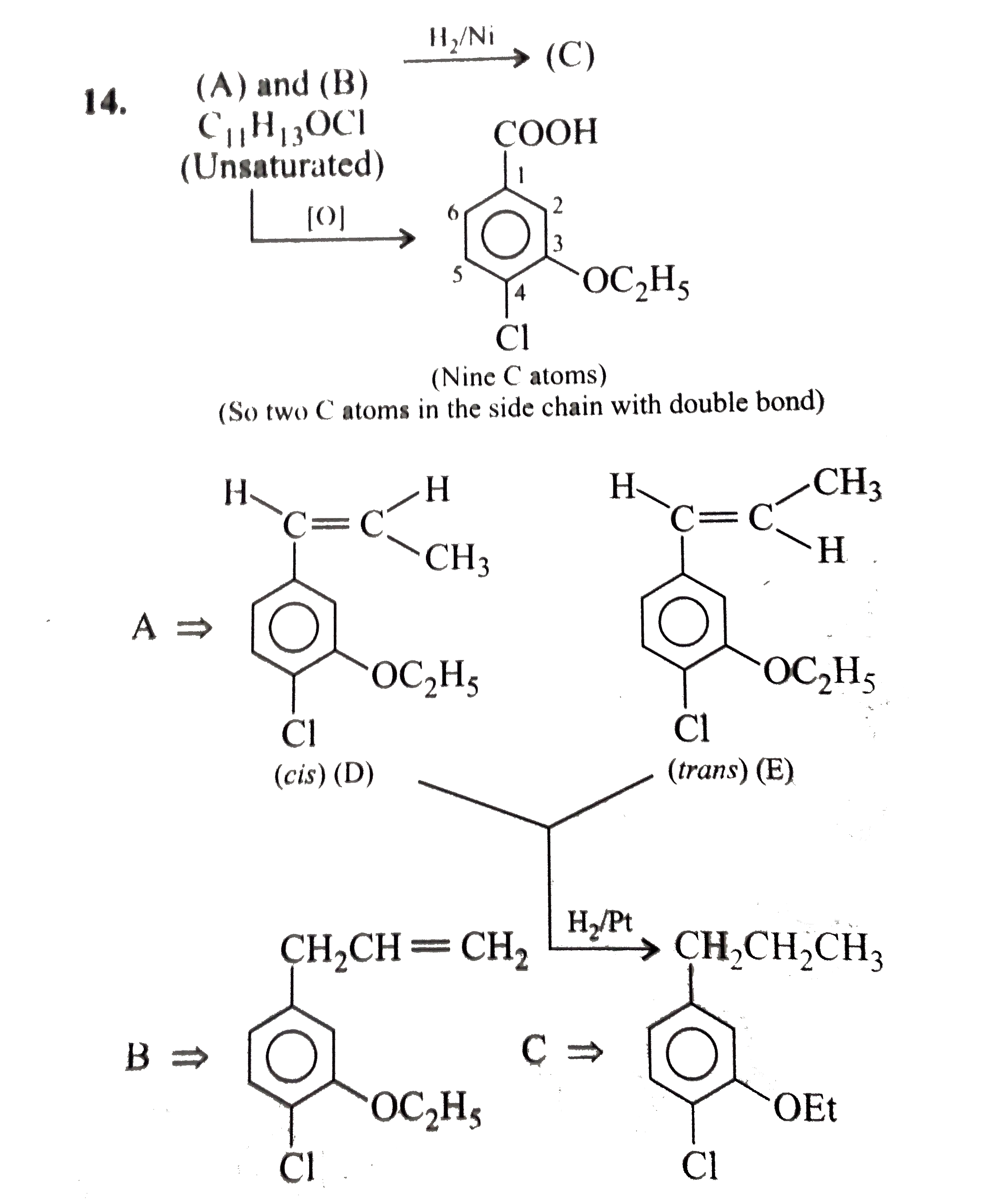Two isomeric compounds, (A) and (B), have the same formula, C11H13OCI. Both are unsaturated, yield the same compound (C) on catalytic hydrogenation, and produce 4-chloro-3-ethoxybenzoic acid on vigorous oxidation. (A) exists in geometrical isomers, (D) and (E), but not (B). Give structures of (A) to (E) with proper reasoning.

(So two C atoms in the side chain with double bond)
Topper's Solved these Questions
- BOOK - CENGAGE CHEMISTRYCHAPTER - ALCOHOL,PHENOL AND ETHERSEXERCISE - Exercises Concept Application33videos
ALCOHOL,PHENOL AND ETHERS
- BOOK - CENGAGE CHEMISTRYCHAPTER - ALCOHOL,PHENOL AND ETHERSEXERCISE - Exercises Linked Comprehension60videos
ALCOHOL,PHENOL AND ETHERS
- BOOK - CENGAGE CHEMISTRYCHAPTER - ALCOHOL,PHENOL AND ETHERSEXERCISE - Solved Examples17videos
ALCOHOL,PHENOL AND ETHERS
- BOOK - CENGAGE CHEMISTRYCHAPTER - ALIPHATIC AND AROMATIC ALDEHYDES AND KETONESEXERCISE - Archives Subjective29videos
ALIPHATIC AND AROMATIC ALDEHYDES AND KETONES
Similar Questions
0.90gm of an organic compound C4H10O2(A) when treated with sodium gives 224ml of hydrogen at NTP. Compound (A) can be separated into fraction (B) and
(C ), by crystallisation of which the fraction (B) is resolved into isomers (D) and (E ). Write down the structural formula of (A) to (E ) with proper reasoning.View SolutionTwo isomeric compounds(A) and (B) have molecular formula C6H10. Oxidation of (A) gives mixture of butanoic and acetic acids, whereas compound (B) gives hexa-1,6-dioicacid. What are (A) and (B)?
View Solution
Knowledge Check
- Question 1 - Select One
Two isomeric compounds A and B have some molecualr formula C3H5N. It was found that
AA and B do not react with NHO2 or CH3COClBOn refluxing with dil. HCl, A gives C and B gives D. Both C and D are monobase carboxylic acids.CMolecular mass of D is 74.DC gives positive Tollen's test whereas D does not predict the structures of A,B,C and D. - Question 2 - Select One
Two organic compounds have the same formula, C4H8O and are isomeric with each other. They are
Aaldehydes and ketonesBalcohols and phenolsCbutanal and butanoneDtert. butyl alcohol and butan-1-ol - Question 3 - Select One
Two isomeric halo alkenes (A) and (B) have molecular formula C5H9Cl. (A) gives optically inactive compound whil (B) give optically active compound in hydrogenation. The two iosmers respectively are:
A3-chloro-1-pentane and 4-chloro-2-penteneB4-chloro-1-pentene and 2-chloro-2-penteneC3-chloro-2-pentene and 1-chloro-2-penteneD1-chloro-1-pentene and 5-chloro-1-pentene
0.90gm of an organic compound C4H10O2(A) when treated with sodium gives 224ml of hydrogen at NTP. Compound (A) can be separated into fraction (B) and
(C ), by crystallisation of which the fraction (B) is resolved into isomers (D) and (E ). Write down the structural formula of (A) to (E ) with proper reasoning.View SolutionTwo isomeric forms of an organic compound (A), C11H13OCI readily decolourise bromine water and give same compound (B) on catalytic hydrogenation. Both the isomeric forms on vigorous oxidation give (C) which on treatment with soda lime gives 2-chloro ethoxy benzene. However, (C) treatment with Ni/Al alloy in alkaline medium gives 3-ehtoxy benzoic acid. Only one of the isomers of (A) gives geometrical isomers (D) and (E). Identify (A) to (E) with proper reasoning.
View SolutionAn organic compound (A)(C5H8O3) on heating with soda lime gives (B) which reacts with HCN to give (C). The compound (C) reacts with thionyl chloride to produce (D) which on reaction with KCN gives a compound (E). Alkaline hydrolysis of (E) gives a salt (F) which on heating with soda lime produces n−butane. Careful oxidation of (A) with dichromate give acetic acid and malonic acid. Give the structures to (A) to (F) with proper reasoning.
View SolutionWhen H2 is added to two isomeric alkenes A and B having molecular formula C5H9Cl, A gives optically inactive compound while B gives a chiral compound. The two isomers are
View SolutionA compound 'A' with formula C3H8O possess two structural isomers. On oxidation it produces an acid. Compound A is
View Solution

